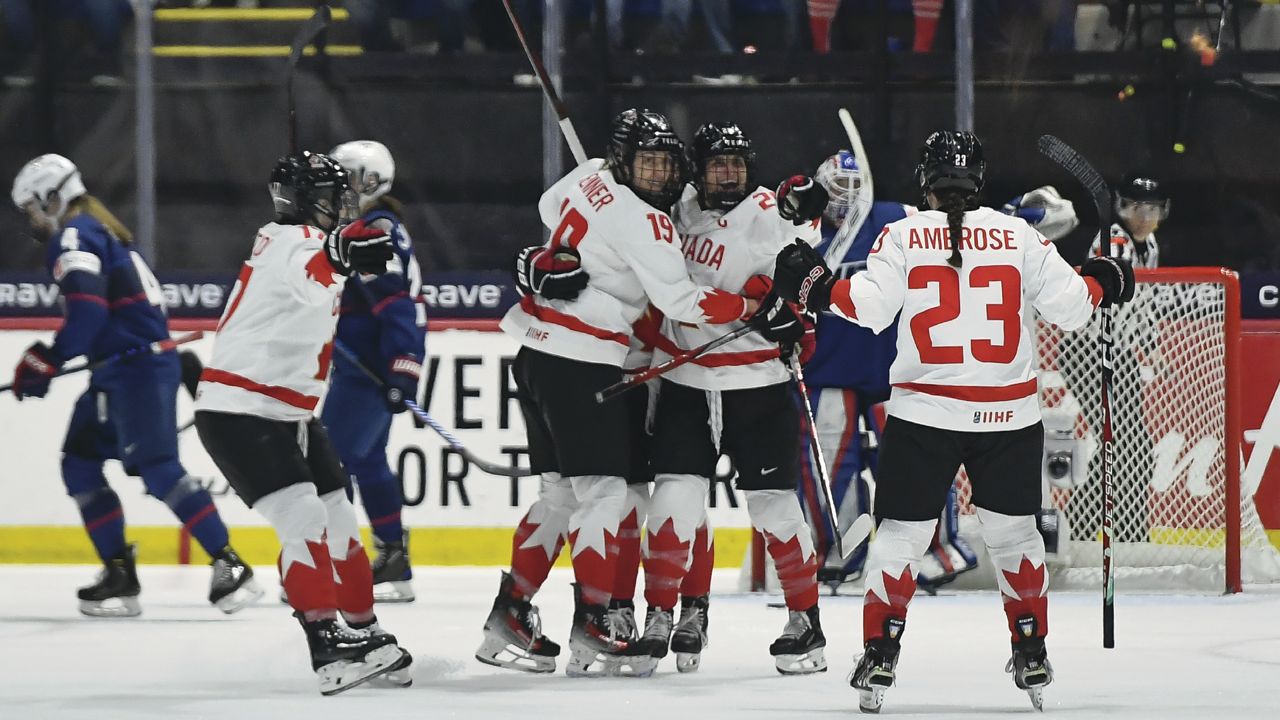


UTICA, N.Y. (AP) — Even with the sting of disappointment evident on her face, United States defenseman Caroline Harvey couldn’t help but acknowledge being part of something special. And riveting.
“I was just on the edge of my seat myself and excited for what was to come,” the 21-year-old said, detailing the relentless intensity put on display in a 6-5 overtime loss to Canada in the women’s world hockey championship gold medal game on Sunday. “The end was devastating. But I was excited to be out there and a part of it.”
Unnerving as it was for Canada coach Troy Ryan to deal with the momentum swings of an outing that featured three lead changes and neither team holding more than a one-goal edge, he enjoyed a brief moment of clarity at one point by telling himself: “I’d love to be a fan sitting up there having a beer watching this one.”
Cheers, to you.
In a 10-team tournament that had several nations — Finland, the Czech Republic and even upstart Germany — showing signs of closing the gap on the sport’s two traditional powers, leave it to the U.S. and Canada to ratchet the bar even higher.
Not once. But twice.
The thrilling finale, decided on Danielle Serdachny’s power-play goal 5:16 into overtime, came six days after the two rivals tangled in a fast-paced and physical 1-0 overtime win sealed by Kirsten Simms, one of four Americans making their tournament debuts.
In the big picture, the breath-taking outings were another reminder of why U.S. versus Canada in women’s hockey stands as the world’s fiercest rivalry, and showcased a sport that’s suddenly gaining traction in North America with this year’s launch of the Professional Women’s Hockey League.
And make no mistake, the PWHL was a predominant topic of discussion on and off the ice throughout the 12-day tournament. And it included league officials spending much of Saturday morning outlining plans with International Ice Hockey Federations officials that have the potential of changing the women’s hockey calendar, and having an even greater impact of growing the sport internationally.
The discussions revolved around moving the timing of the world championships from April so not to disrupt the PWHL season, which resumes on Thursday, with each of the league’s six teams having five games left.
Another topic was having the PWHL partner with European leagues in Sweden and Switzerland to became potential developmental partners. With the PWHL not considering expansion until after the 2024-25 season at the earliest, a feeder system becomes necessary to develop talent and provide women a place to play following their college careers.
PWHL roster spots are already at a premium even before its draft in June, which will feature a new crop of college graduates and with as many as 100 European players expected to declare being eligible for selection.
Though made up of mostly U.S. and Canadian national team players, the PWHL is eager to attract international talent if it intends to consider itself the world’s top women’s league. Many European federations already rely on their players developing at U.S. colleges, and consider the PWHL to be a natural extension.
“To see the popularity and fan base that’s come out, I think it’s phenomenal,” Switzerland coach Colin Muller told The Associated Press. “But I don’t know if we don’t need more teams. I think we have enough good hockey players for eight teams at least. And I think they should grow it a little faster for me.”
The PWHL is taking a more cautious approach to not grow too quickly, while acknowledging it still has numerous issues to sort out entering its second season. Among them are finding proper-sized venues, and making inroads in the New York City market, after failing to generate interest playing out of Bridgeport, Connecticut.
What everyone can agree on is the best way of bridging the competitive gap in women’s hockey is non-North American players having more opportunities to play with or against Americans and Canadians.
“We’re never playing against those teams. We always meet them here. So it’s tough to get on their level,” Czech goalie Klara Peslarova said, before breaking into a laugh. “Maybe they’re scared to meet us.”
As a stop-gap, the IIHF has had discussions with USA Hockey and Hockey Canada to at the very least have their Under-22 teams begin participating more regularly in European tournaments.
It remains to be seen how wide the gap remains, especially after the show put on by the U.S. and Canada on Sunday.
“I do think that’s a fair example of what an amazing sport women’s hockey is. And I think it’s a glimpse of where it could be, going forward,” U.S. coach John Wroblewski said. “I think the execution level can continue to rise, at which point the puck is moving at a speed similar to the men’s.”